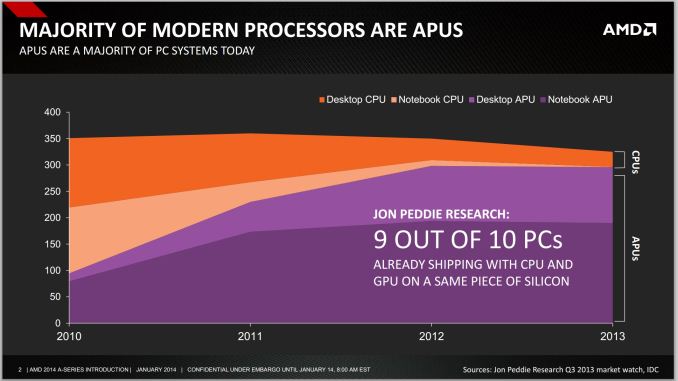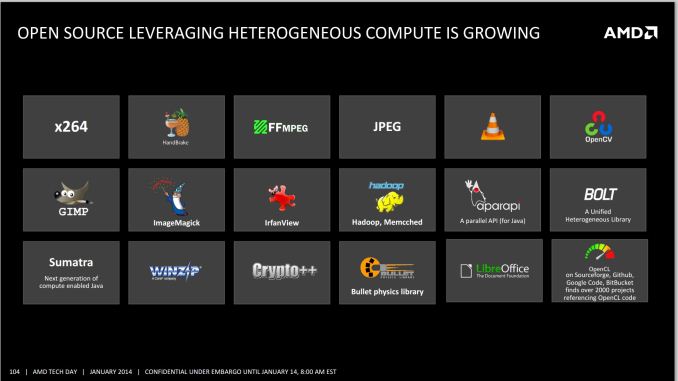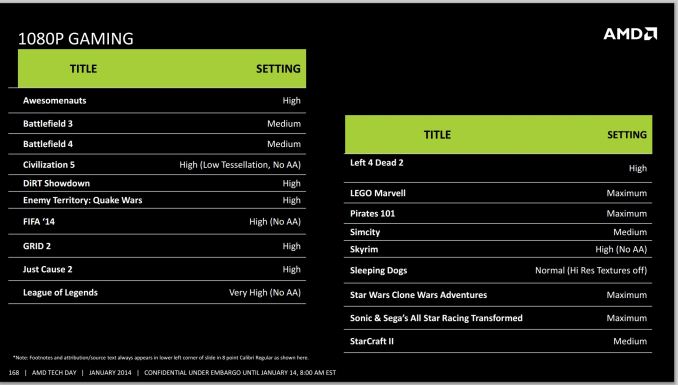AMD Kaveri Review: A8-7600 and A10-7850K Tested
by Ian Cutress & Rahul Garg on January 14, 2014 8:00 AM ESTKaveri: Aiming for 1080p30 and Compute
The numerical differences between Kaveri and Richland are easy enough to rattle off – later in the review we will be discussing these in depth – but at a high level AMD is aiming for a middle ground between the desktop model (CPU + discrete graphics) and Apple’s Mac Pro dream (offloading compute onto different discrete graphics cards) by doing the dream on a single processor. At AMD’s Kaveri tech day the following graph was thrown in front of journalists worldwide:
With Intel now on board, processor graphics is a big deal. You can argue whether or not AMD should continue to use the acronym APU instead of SoC, but the fact remains that it's tough to buy a CPU without an integrated GPU.
In the absence of vertical integration, software optimization always trails hardware availability. If you look at 2011 as the crossover year when APUs/SoCs took over the market, it's not much of a surprise that we haven't seen aggressive moves by software developers to truly leverage GPU compute. Part of the problem has been programming model, which AMD hopes to address with Kaveri and HSA. Kaveri enables a full heterogeneous unified memory architecture (hUMA), such that the integrated graphics topology can access the full breadth of memory that the CPU can, putting a 32GB enabled compute device into the hands of developers.
One of the complexities of compute is also time: getting the CPU and GPU to communicate to each other without HSA and hUMA requires an amount of overhead that is not trivial. For compute, this comes in the form of allowing the CPU and GPU to work on the same data set at the same time, effectively opening up all the compute to the same task without asynchronous calls to memory copies and expensive memory checks for coherency.
The issue AMD has with their HSA ecosystem is the need for developers to jump on board. The analogy oft cited is that on Day 1, iOS had very few apps, yet today has millions. Perhaps a small equivocation fallacy comes in here – Apple is able to manage their OS and system in its entirety, whereas AMD has to compete in the same space as non-HSA enabled products and lacks the control. Nevertheless, AMD is attempting to integrate programming tools for HSA (and OpenCL 2.0) as seamlessly as possible to all modern platforms via a HSA Instruction Layer (HSAIL). The goal is for programming languages like Java, C++ and C++ AMP, as well as common acceleration API libraries and toolkits to provide these features at little or no coding cost. This is something our resident compute guru Rahul will be looking at in further detail later on in the review.
On the gaming side, 30 FPS has been a goal for AMD’s integrated graphics solutions for a couple of generations now.
Arguably we could say that any game should be able to do 30 FPS if we turn down the settings far enough, but AMD has put at least one restriction on that: resolution. 1080p is a lofty goal to hold at 30 FPS with some of the more challenging titles of today. In our testing in this review, it was clear that users had a choice – start with a high resolution and turn the settings down, or keep the settings on medium-high and adjust the resolution. Games like BF4 and Crysis 3 are going to tax any graphics card, especially when additional DirectX 11 features come in to play (ambient occlusion, depth of field, global illumination, and bilateral filtering are some that AMD mention).













380 Comments
View All Comments
drezden444 - Tuesday, January 14, 2014 - link
AMD is very important. Without AMD, Intel was still going to sell us those crappy P4 CPU for 1000$ for a single core unit. Well, please do something - be better. 2 years you can't come out with a better product than old Phenom CPU. I'm doing my job to help you - I'm building myself an AMD PCs - always, but if I could afford a second computer, it was going to be an Intel build. And just to finish. Now I'm buying myself FX6300+7770, just for few dollars more than your Kaveri APU, really disappointed for not seeing this Steamroll cores in FX AM3+ version.Nagorak - Wednesday, January 15, 2014 - link
AMD may be getting close to being done. They haven't been competitive in a long time. Even now the place where this sort of integrated GPU would be helpful (mobile) they aren't competitive. In their infinite wisdom they sold off their mobile graphics division to Qualcomm, and it's now doing pretty damn well.A company can only make so many boneheaded moves before giving up the ghost.
Da W - Tuesday, January 14, 2014 - link
Here's what goes into my old Phenom X3 HTPC.Say hello to a new steambox used for streaming from my beast.
Da W - Tuesday, January 14, 2014 - link
I personnaly have an i7 4770K and my dick is not any bigger. Take that intel fanboys!silverblue - Tuesday, January 14, 2014 - link
There's a few things that can be inferred about Kaveri. The first is that there's little point going above 65W, let alone 45W, unless minimum framerates are the most important thing to you (Kaveri suffers here anyway, though at unrealistically low rates). Secondly, single threaded performance is still poor - Steamroller's main benefit is removing the MT bottleneck and it appears to have succeeded, but the hope was for a bit more. Finally, having 512 shaders means little over 384 at the moment (drivers and bandwidth permitting).It may be worth revisiting these results in a few months when some of the benches can benefit from HSA, and TrueAudio and Mantle are in use along with more mature drivers, but regardless, the A8-7600 looks like the sweet spot. I had hoped for more on the CPU front, but I guess that's yet to come. A 45W Carrizo built using high density libraries would probably equal the 7850 at the very least. A 95W Kaveri with lower clocked CPU cores and 768 cores would be very interesting indeed.
I think I can see why there are no FX CPUs planned, but we don't know the benefit of L3 on performance without them.
JDG1980 - Tuesday, January 14, 2014 - link
The GPU is pretty clearly bottlenecked by memory bandwidth. It doesn't matter how many shaders they throw at it as long as they're stuck on DDR3. They need to either move to DDR4/GDDR5 as system memory, or add extra cache RAM on-die. Until then, iGPU performance won't get much (if any) better. The extra shaders will still help in GPGPU applications, though.thomascheng - Tuesday, January 14, 2014 - link
To me, this APU is perfect for SteamBox. GPU centric over CPU, dedicated Audio processor, Mantle, allows for small form factor. The chip itself sounds like a console.Krysto - Tuesday, January 14, 2014 - link
HSA seems like a nice architecture, but I wonder what's in it for the ARM chip makers? Why would they standardize a compute architecture like this around a pseudo-ISA, when they could all do it on top of ARMv8, and it would probably greatly simplify things for them and with better performance, too?Is it because they hope that HSAIL being supported by Microsoft will eventually make it possible for new apps to run on both x86 and ARM? But Microsoft has already done that with WinRT.
So I don't get it. Why would ARM and its ARM partners want to be involved in this, when they could build their own HSA-alternative and they wouldn't have to drag AMD along with them, which let's face it, are not successful in PCs and inexistent in mobile.
codedivine - Tuesday, January 14, 2014 - link
HSAIL is a pseudo-ISA not only for the CPU, but also for the GPU. There is no standardized pseudo-ISA for the GPU other than HSAIL. ARMv8 only applies to the CPU side.davio - Tuesday, January 14, 2014 - link
a 7 yr old asus motherboard with 4gb ram and athlon 64 x2 2200+ with a 1gb bfg GTS 250 graphic card. UPGRADING : would a new fm2+ board with an A10-6800K be equivalent with graphics for ADOBE and AUTOCAD...(NO GAMING...EVER) OR would the new a10 kaveri be better ?